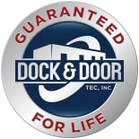|
In everyday life, there is a risk in just about everything we do. Most of that risk is so insignificant that we don’t even give it a thought. In a warehouse and especially at a loading dock the risk increases drastically. OSHA makes the following statement on their website, “loading docks can be dangerous places for forklifts, falls from a loading dock in a forklift can be fatal.”
With a combination of personnel, heavy equipment, moving product and trucks in the docks, the risks are endless. So, how do you assess risk and what do you do with that assessment? Webster Defines Risk as: risk noun \’risk\ : the possibility that something bad or unpleasant (such as injury or loss) will happen : someone or something that may cause something bad or unpleasant to happen : a person or thing that someone judges to be a good or bad choice for insurance, a loan, etc. It’s clear that working on a loading dock can be risky. Lots of heavy moving parts combined with foot traffic and moving trucks. Maybe the bigger questions are:
It is critical to understand the risk in your warehouse and how to mitigate that risk as much as possible. Part of risk mitigation is understanding the costs of death or injury versus the cost of equipment meant to limit the risk. I can tell you in no uncertain terms that the cost and maintenance of a truck restraint or a properly maintained dock leveler are far less costly than a serious injury or death. Have no doubt, mitigating or eliminating risk is attainable, it takes a commitment from management and staff. It takes a clear understanding of the risk and the expenses of doing everything or doing nothing. If you would like more information on risk management or mitigation please contact any of us at Dock & Door Tec. We will be happy to take a look at your facility, listen to you and provide you with a plan to help mitigate your risk. What is the biggest ROI in your warehouse? Most valuable of course is the people, your employees, and co-workers. However, the item which provides the biggest return on investment is the loading dock bumpers.
Before you laugh at me consider how inexpensive they are compared to the cost of having one fail or come off of the wall. They are the single most important item on the loading dock. Everything on a loading dock layout is measured in inches, when a bumper is missing or worn a backing truck will over-penetrate the dock opening causing severe consequences. Truck restraints will not engage properly, dock seals will be over-compressed, levelers will get damaged as will building walls. Over the years I have seen entire dock areas need to have walls repaired and equipment replaced due to bad bumpers. Considering a dock seal can cost $300-$3000, a dock leveler $800-$8000 and wall repairs can exceed $10,000 in repairs why would anyone not replace a dock bumper which only costs $25-$300? When replacing dock bumpers be sure a full layout is done to ensure the correct projection – this is critical. The size and type of bumper is important as well. There are many types of bumpers, such as molded, laminated, steel-faced, spring steel and pneumatic. It is no secret you get what you pay for, this is true with dock bumpers. When replacing a dock bumper, be sure the installation company guarantees their work. A properly applied, installed and utilized dock bumper will never come off of the wall – make sure your installer guarantees this. Any voids or poor concrete behind the bumper will result in premature failure. Also if no vertical curb angle is present, steel plating should be done. Never anchor a bumper flange on the edge of the dock pit – it will fail. Installation is critical. Remember how important your dock bumpers are and how much ROI they offer. Be sure to check them on walk-through and inspections. All it takes is one backing truck and a missing bumper. The damage will occur. Feel free to contact me anytime with any questions on dock bumpers or loading dock equipment. Jay Anderson Owner, Dock & Door Tec It finally appears that we’re done with snow for a few months, keep your fingers crossed. Many things are springing to life as we move into mosquito and construction season. I have recently visited with a couple customers that are fighting a battle with birds and another with bugs. These types of intrusions can bring operations to a screeching halt in many facilities. Pests bring about problems that can range from a minor distraction to safety issues to sanitary problems and inspection failures in medical and food processing environments.
There are many types of solutions to these types of issues:
Your loading dock area really is an entire system in which all the components work together to keep the outside out and the inside in. A failure in any one of the areas creates the possibility of some of those outside things making their way inside. We’d be happy to evaluate your facility with you to determine if improvements can be made. Give us a call at DDT to have a representative stop out. Brett Korinek Account Manager, Dock & Door Tec Many facility supervisors look at their warehouses not from the outside, but from the inside. Let’s face it, you get to work, go inside the warehouse and spend the rest of the day inside taking care of business.
Who is responsible for going outside and doing an actual equipment survey? Have you looked under your dock levelers, at your dock seals, checked the quality of your dock bumpers and wheel chocks or truck restraints (dock locks)? If you are responsible for “safety”, “efficiency”, “productivity” and “compliance” now is the time. Small repairs left unchecked can lead to huge expenses and sometimes –employee injuries. Here are some simple tips to help you look like the “Smartest Guy on the Dock” and not the “New Kid on the Block” when inspecting your loading dock
For more information: Click Here Keeping a well-maintained dock area not only helps things run smoothly, but it also shows that your company takes pride in its shipping and receiving area, is energy conscientious, and knows that safety is most important. |
AuthorVarious. Categories
All
Archives
August 2023
|
- Home
- About
- Career Opportunities
- Services
-
Equipment
- Dock Locks (Truck Restraints) >
- Fans & In-Plant Equipment >
-
Industrial / Commercial Doors
>
- High Speed Fabric Doors
- Security High Speed
- Rubber Doors
- Fire Door
- Rolling Steel
- Impactable Dock Doors
- Cooler / Freezer
- Fabric Roll-Up
- Impact / Traffic / Bump
- Overhead / Sectional Doors
- Operators / Activation
- Air Curtains / Screen & Bug Doors
- Strip Doors
- Door Entrapment Protection
- Door Protection
- Overhead Door Upgrades
- Loading Dock Levelers & Lifts >
- Loading Dock Seals & Shelters >
- OEM & Aftermarket Parts
- Safety / Energy / Security / Employee Comfort >
- Yeti Snow Removal
- Markets
- Blog
- Contact
Dock & Door Tec
Serving Minnesota, Wisconsin, Iowa, North Dakota & South Dakota
Serving Minnesota, Wisconsin, Iowa, North Dakota & South Dakota

 RSS Feed
RSS Feed
